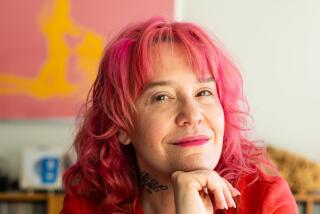Books & Ideas: An author’s adventures in ‘Anthropology’
Reporting from New York —
On the day, less than two weeks ago, that Hilary Thayer Hamann’s first novel arrived in bookstores, the author was anything but elated. “It’s actually really nerve-racking,” confessed the author of “Anthropology of an American Girl” (Spiegel & Grau: 610 pp., $26) as she slid into a chair at Pasticceria Bruno, an old-world Italian bakery in Greenwich Village near New York University. “Everyone says, ‘You should be so excited! You should be so happy!’ But I feel more concerned than excited.” She shrugs. “I have too much knowledge.”
If Hamann sounds a bit cynical, it’s because she’s been through this all before — literally. In 2003, she self-published this same novel, a dense and sprawling investigation of Western-style womanhood with that irresistibly grand title. In the years that followed, Hamann, who has three children, devoted her all to finding an audience. “It was just really hard to get people to buy the books,” she says with a wry laugh. This time around, she has a major publisher — Spiegel & Grau is an imprint of Random House — for which she’s perhaps more grateful than your average writer. “I was in the trenches,” said the author, who has dark eyes and dark hair streaked with icy blond. “I’m grateful every day for all the things I don’t have to do. Self-publishing requires stamina.”
In mainstream literary circles, self-publishing is generally considered the exclusive realm of egomaniacs, eccentrics and failures — those who’ve been rejected by mainstream outlets but are too deluded to realize the worthlessness of their work. There are, certainly, those rare tales of self-publishing success. But in the past few years — as sites such as Amazon and Lulu have made it easier and cheaper — self-publishing has taken off like wildfire. Last year alone saw the self-publication of more than half a million books. Some, like Hamann’s, are finding homes with traditional houses. “Publishers are taking self-published books more seriously,” said Sara Nelson, books editor for O, the Oprah Magazine and former editor of Publishers Weekly. “Ten years ago it was a very rare thing that a publisher picked up a self-published book. Now it’s happening more frequently.” Though not all that often. Most self-published titles sell only a few handfuls of copies.
But Hamann turned to self-publishing in the spirit of entrepreneurship rather than desperation. She and her then husband, a designer, had launched a printing business. “It just made sense for us to publish it.” The idea, she explains, was to turn the press into a true publisher, with “Anthropology” as their first venture. Neither Hamann nor her husband had any real background in publishing, though, and the learning curve was enormous.
“We found out that in order to get reviewed we needed to get certain long-lead magazines the book prior to publication, which we didn’t understand,” she said. “So we had to set the pub date back and then give them something, a galley, to review.” Hamann gave the galleys creamy letterpress covers, numbered and signed like limited-edition art books. “We made 500 and we sent it everywhere, from the New York Times to Vogue to I don’t know.”
While no major papers reviewed the novel, some student publications, intrigued by the title and packaging — and perhaps more inclined to flip through a galley from an unknown press — wound up covering the book, favorably so. Hamann slowly built a file of reviews, which she then used to persuade bookstores to stock the book. “We literally went state by state and called every single bookstore,” she explained. “We would pitch the book and ship them the sample copy, and hopefully they’d order a few, then order a few more, and that was how we moved the book.” Ultimately, she sold some 5,000 copies, a respectable figure for a traditionally published first novel, much less a self-published one.
Yet by June 2007, Hamann had entered into “a dark time.” The novel — as well as the one other book she and her husband had published, a compendium she edited on physics, literature and art — simply wasn’t earning enough money to make the publishing venture sustainable. Hamann’s staff, by this point, had dwindled to herself and seven interns: “I’d invested heavily into this, and I couldn’t reprint. I couldn’t maintain the staff.” Then, out of nowhere, a fax arrived from a film producer interested in optioning the book. Nothing came of it, but the producer encouraged Hamann — who’d devoted much of her adult life to writing the novel, “stitching together moments” when her children were infants — to seek a mainstream publisher. Hamann sent copies to a few agents. Within a week, she’d signed with one, and a few months later, she was signing a contract with Spiegel & Grau, an imprint known both for launching literary writers such as Philipp Meyer and for more popular tomes such as Suze Orman’s finance guides.
But “Anthropology” — despite the seductive title and accessible subject matter — is rather more experimental than even the most literary novels put out by major publishers. Deeply philosophical, decidedly not plot-driven and written in a style that sometimes verges on the self-consciously poetic, the volume has the meandering, associative feel of a journal. “Had I sent the book out [to agents] originally I don’t know what reception it would have gotten,” she said. “But I can say that at the time the kinds of works that were being published were shoving stereotypes down one’s throat.” She’s referring here to chick lit, of course. “Everything had shoes on the cover or a stockinged calf, like pulp fiction novels.”
In fact, Hamann’s intention from the start was to investigate and interrogate those stereotypes rather than traffic in them. She began devising the novel more than 15 years ago, after finishing postgrad work in anthropological filmmaking at NYU. “There was a lot of talk about people from other cultures, and Americans were always classified as being privileged and oblivious and to blame for a lot of the inequity on the planet,” she said of her coursework. “I thought that one piece that was missing was kind of a self-investigation. I didn’t feel privileged or oblivious, I felt that my parents had struggled and had reversals, and my grandparents had struggled and had reversals.” She began reading through years and years of journals and, realizing she had a “field guide to high school” on her hands, decided to translate those thoughts and observations into “an anthropological investigation of a young girl growing into womanhood. The struggles she faces to survive. The compromises she’s called upon to make to protect herself … a story of social survival.”
Set in the late 1970s and early 1980s, the result — trimmed and reorganized since its original publication — is an oddly mesmerizing account of the growing pains of Eveline Auerbach, an introspective teen who lives on the wrong side of the tracks in tony East Hampton and who observes the world around her with brilliant precision and intellectual precocity. If Evie isn’t exactly the average American girl suggested by the title — she’s so gorgeous, for instance, that every man who crosses her path falls desperately in love with her — there’s certainly a universality to her experiences and emotions as she muddles through her senior year of high school, growing apart from her oldest friend, dumping her longtime boyfriend and falling for a mysterious older man, Rourke, the new drama coach, before they’ve even spoken a word to each other: “He seemed to know me as I knew him; instantly we entered into confidence.”
After an idyllic summer together — “I discovered … the feminine genius of me” — Rourke leaves without explanation, and Evie heads off to NYU. Bereft, she seeks solace in Rourke’s wealthy friend Mark, a trader who, in the novel’s one false move, reads a bit like an extra from “Wall Street,” (“I have all the money you’ll ever need,” he says as they have sex for the first time), but pines for Rourke, who it turns out is less an actor and more a small-time fighter, a fact he kept from her because of shame.
If the novel lacks conventional narrative momentum, it certainly possesses the strange, uneven texture of real life — one year passes with excruciating slowness; the next four in a blur of despair — exactly how Hamann intended it. “It’s a new way of looking at an old situation,” she said.
The same could be said for Hamann’s adventures in self-publishing, a venture that she threw herself into having no idea where it would lead her. But, as Michael Cader, the force behind the industry e-newsletter Publishers Lunch notes, Hamann’s gamble could have easily gone in a different direction: “Sometimes the publishers are [wrong], and there is a substantially larger market that the author was able to find on their own. And sometimes they’re not wrong, and there was a reason the book was self-published in the first place.”
Smith Rakoff is the author of the novel “A Fortunate Age.”
More to Read
The biggest entertainment stories
Get our big stories about Hollywood, film, television, music, arts, culture and more right in your inbox as soon as they publish.
You may occasionally receive promotional content from the Los Angeles Times.






